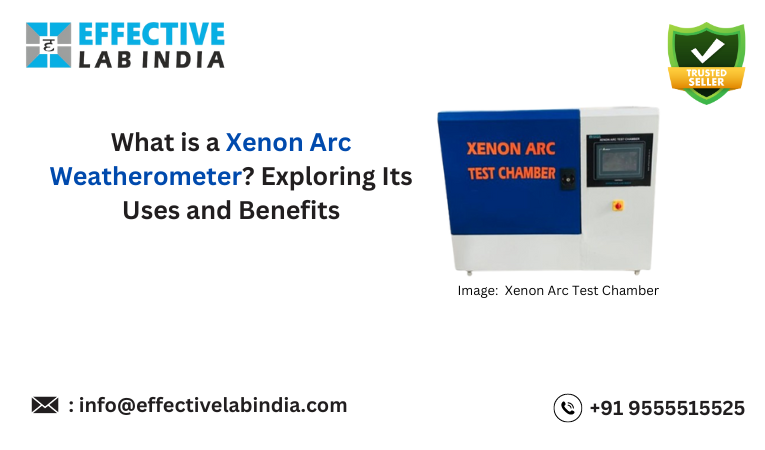What is a Xenon Arc Weatherometer? Exploring Its Uses and Benefits

A xenon arc weatherometer is a specialized instrument used to simulate and accelerate weathering effects on materials. It utilizes xenon arc lamps to reproduce the full spectrum of sunlight, including ultraviolet (UV), visible, and infrared light. These weatherometers are crucial in various industries for evaluating the durability and performance of materials when exposed to outdoor environmental conditions.
Understanding the Technology Behind Xenon Arc Weatherometers
The basis for xenon arc test chamber operation is their ability to produce light that closely resembles sunshine. The lamps provide bright light at various wavelengths, giving exact control over exposure parameters like humidity, temperature, and UV intensity. With the use of this skill, researchers and manufacturers may forecast the behaviour of materials over long time periods, such as months or years of exposure in the natural world.
Components of a Xenon Arc Weatherometer
A xenon arc weatherometer typically includes:
- Xenon Arc Lamp: Produces bright, spectrum-spanning light.
- Specimen Holder: The location of the test materials.
- Temperature and Humidity Control: Controlling the temperature and humidity makes sure that the test circumstances are similar to actual ones.
- Rotating Drum or Rack: A rotating rack or drum makes it easier for samples to be exposed consistently.
Uses of Xenon Arc Weatherometers
Automotive Industry
Effective Lab Xenon arc weatherometers are used in the automotive industry to evaluate how resistant paints, polymers, and textiles are to sunshine, moisture, and temperature changes, among other factors. The lifetime and visual quality of the product are enhanced by this testing.
Textile Sector
These weatherometers are used by textile manufacturers to assess the colorfastness and strength of their fabrics in outdoor environments. They guarantee that fabrics hold their colour and structural integrity over time by mimicking sunshine exposure.
Coatings and Paints
Xenon arc weatherometers are used to simulate outdoor exposure and evaluate the colour fading, cracking, and general longevity of paints and coatings. The results of this experiment help formulate outdoor-use UV-resistant coatings.
Advantages of Using Xenon Arc Weatherometers
- Accurate Simulation: Enables accurate testing by simulating the spectrum of natural sunshine.
- Accelerated Testing: Faster than natural weathering, accelerated testing yields results.
- Predictive Capability: Ability to predict material degradation and optimise product compositions is a benefit of predictive capability for producers.
- Standardized Testing: Industry standards for quality assurance and legal compliance are met via standardised testing.
Xenon Arc Weatherometer Buying Considerations
Factors to take into account while choosing a xenon arc weatherometer are:
- Testing Standards: Check that the equipment satisfies applicable industry standards (such as ASTM or ISO) by testing it.
- Size and Capacity of the Sample: A model that meets your testing requirements should be chosen.
- Maintenance Requirements: requirements for maintenance Recognise the maintenance requirements, such as calibrating and replacing lamps.
What is the standard for xenon arc testing?
Effective Lab India xenon arc testing standard to set guidelines to guarantee uniformity and dependability across industries. It is utilised to mimic the impacts of sunshine on materials. The International Organisation for Standardisation (ISO) and ASTM International are two of the major international organisations whose standards govern xenon arc testing.
ASTM Standards
ASTM G155 – Standard Practice for Operating Xenon Arc Light Apparatus for Exposure of
Non-Metallic Materials: This standard describes the procedures for simulating sunlight exposure for non-metallic materials using xenon arc light apparatus. It describes the exposure characteristics in detail, including temperature, humidity, and light intensity.
ASTM D2565 – Standard Practice for Xenon-Arc Exposure of Plastics Intended for Outdoor
Applications: Plastics intended for outdoor usage are protected from xenon-arc radiation by the ASTM D2565 standard procedure. This process provides detailed directions for subjecting polymers to xenon arc light to evaluate their outdoor performance and durability. It includes guidelines for preparing the specimen, handling it during exposure, and assessing it.
Conclusion
Effective Lab Xenon test chamber play a crucial role in testing and validating the durability of materials across diverse industries. By simulating outdoor weathering conditions, these instruments enable manufacturers to enhance product quality, longevity, and performance.
- Industry
- Art
- Causes
- Crafts
- Dance
- Drinks
- Film
- Fitness
- Food
- Games
- Gardening
- Health
- Home
- Literature
- Music
- Networking
- Other
- Party
- Religion
- Shopping
- Sports
- Theater
- Wellness
- News


